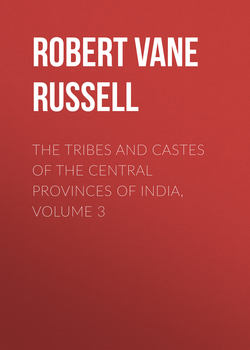Читать книгу The Tribes and Castes of the Central Provinces of India, Volume 3 - Robert Vane Russell - Страница 59
Gond
(f) Religion
41. Tribal gods, and their place of residence
ОглавлениеBesides the village gods worshipped in common with the Hindus, the Gonds have also their special tribal gods. These are sometimes kept at a Deo-khulla, which is said to mean literally the threshing-floor of the gods, and is perhaps so called because the place of meeting of the worshippers is cleaned and plastered like a threshing-floor in the fields. The gods most commonly found are Pharsi Pen, the battle-axe god; Matiya, the great god of mischief; Ghangra, the bell god; Chāwar, the cow’s tail, which is also used as a whisk; Pālo, who consists of a piece of cloth used to cover spear-heads; and Sale, who may be the god who presides over cattle-pens (sāla). The Deo-khulla of a six-god Gond should have six, and that of a seven-god Gond seven gods, but this rule is not regularly observed, and the Deo-khullas themselves now tend to disappear as the Gonds become Hinduised and attention is concentrated on the village and household gods. The collection of gods at a Deo-khulla, Mr. Tawney remarks, is called Bura Deo, and when a Gond swears by Bura Deo, he swears by all the gods of his sect. “The gods,” Mr. Tawney writes, “are generally tied up in grass and fixed in the fork of the sāj tree, or buried in some recess in the forest, except Pālo, who is put in a bag to prevent his getting wet, and Chāwar the cow’s tail. The Bhumkas or priests are somewhat shy of showing the gods at the Deo-khulla, and they may have some reason for this, for not long since, a young scamp of a Muhammadan, having determined to put to a test the reputed powers of the Gond gods for evil, hid himself in a tree near the Deo-khulla during a meeting, and afterwards took the gods out and threw them bag and baggage down a well. However, when I went there, the Bhumka at Mujāwar after some parley retired into the forest, and came out quite confidingly with an armful of gods. The Deo-khulla gods are generally all of iron, and those at Mujāwar were all spear-shaped except Pālo, who is a piece of cloth, and Ghangra, who is of bell-metal and in form like the bells ordinarily put round the necks of bullocks. When a spear-head has been lost, and another is not available, anything in the shape of a pike or spear will do, and it does not appear to make any difference so long as iron is the metal used. Women may not worship at the Deo-khulla. It seems clear that the original gods were, with the exception of Ghangra, hunting-weapons and representations of animals. Ghangra may be venerated because of his association with bullocks and also on account of the melodious sound made by bullock-bells. Of all the gods the most remarkable probably is Pālo. He is made of cloth and acts as a covering for the spear-heads at the time of worship. The one I saw was a small cloth, about 30 by 18 inches, and in the form of a shield. He is a very expensive god and costs from Rs. 50 to Rs. 80, his outside value perhaps being Rs. 5. When a new one is required it has to be made by a Katia or Rāj-Pardhān, who must live in a separate house and not go near his own till its completion. He must also be naked while he is working and may not eat, drink, smoke or perform natural functions till he has finished for the day. While engaged on the cloth he is well fed by the Gonds and supplied with fowls and spirits; it is not surprising, therefore, that the god is never finished in six months, though I would engage to make one in a week. The cloth is embroidered with figures in coloured silk, with a stitch or two of red silk in each animal, which will subsequently represent blood. The animals I saw embroidered were a bullock, some sort of deer, a gouty-looking snake with a body as thick as the elephant’s, and the latter animal barely distinguishable from it by having two legs and a trunk. When ready the cloth Pālo is taken to the Deo-khulla and a great worship is held, during which blood is seen to flow from the figures on the cloth and they are supposed to be endowed with life.” The animals embroidered on the cloth are probably those principally revered by the Gonds, as the elephant, snake, deer and bullock, while the worship of the cloth itself and the embroidery on it indicates that they considered the arts of weaving and sewing as divinely revealed accomplishments. And the fact that the other gods were made of iron shows a similar reverence for this metal, which they perhaps first discovered in India. At any rate the quarrying and refining of indigenous iron-ore is at present carried out by the Agarias, a caste derived from the Gonds. The spear-head shape of most of the gods and that of Pālo like a shield show their veneration for these weapons of war, which are themselves sacred.
